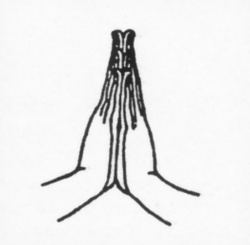Añjali Mudrā
Reverence Gesture
Sjoquist p. 33 Añjali Mudrā or Vajra-Añalikarma Mudrā or Namaskara Mudrā
jīngāng hézhǎng 金刚合掌 金剛合掌 or héshí yìn 合十印
This gesture indicates reverence and salutation. This gesture is used in India as a salutation.
It is also so used among Chinese Buddhists in meeting clerics and among the nuns and monks themselves. (The Chinese term hézhǎng means “hand clasp” rather than mudrā.) It occasionally also occurs in non-Buddhist contexts.
The two palms pressed together under the mouth are thought to indicate homage to the words of a teacher.
Since the Buddha after his enlightenment owes homage to no person, representations of the Buddha rarely show him using this gesture (except toward his parents). Those who seek a deeper meaning see in the two hands placed together the union of the spiritual and material, the static and the dynamic, or even the yīn and the yáng.
